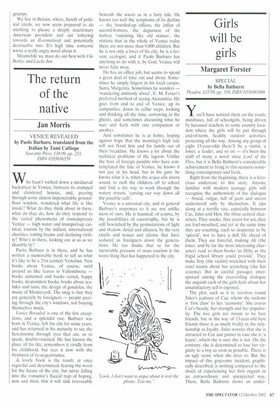The return of the native
Jan Morris
VENICE REVEALED by Paolo Barbaro, translated from the Italian by Tami Calliope Souvenir Press, £10.99, pp. 233, ISBN 0285636359 Who hasn't walked down a mediaeval backstreet in Venice, between its cramped and cloistered houses, and, peering through some almost impenetrable groundfloor window, wondered what life is like inside? What do they think about in there, what do they do, how do they respond to the varied phenomena of contemporary Venice — high water and trumped-up carnival, tourists by the million, international charities, rotting beams and declining virility? Who's in there, looking out at us as we shamble by?
Paolo Barbaro is in there, and he has written a memorable book to tell us what it's like to be a 21st-century Venetian. New books about Venice, of course, swirl around us like leaves in Vallombrosa — books autumnal and books vernal, happy books, despondent books, books about seatides and nuns, the design of gondolas, the music of Monteverdi. The snag is that they are generally by foreigners — people peering through the city's windows, not busying themselves inside.
Venice Revealed is one of the few exceptions, and a splendid one. Barbaro was born in Venice, left the city for some years, and has returned in his maturity to see the Serenissima through eyes that are, so to speak. double-visioned. He has known the place all his life, remembers it vividly from his childhood, but sees it now with the freshness of re-acquaintance.
A lovely book is the result, at once regretful and determined, fearing the worst for the future of the city, but never falling into the romantic's flaccid trap of hoping, now and then, that it will sink irrevocably beneath the waves as in a fairy tale. He knows too well the symptoms of its decline — the boarded-up offices, the influx of second-homers, the departure of the natives 'vanishing like old statues', the statistic that in the whole of Venice today there are not more than 8,000 children. But he is not only a lover of his city, he is a fervent ecologist, and if Paolo Barbaro has anything to do with it, by God, Venice will never fade away.
He has an office job, but seems to spend a great deal of time out and about. Sometimes he simply lingers in his local campo, Santa Margerita. Sometimes he wanders — 'wandering aimlessly about', E. M. Foster's preferred method of seeing Alexandria. He goes from end to end of Venice, up its campaniles, down its cellar steps, looking and thinking all the time, sorrowing in the ghetto, and sometimes discussing what he sees and feels with one companion or another.
And sometimes he is at home, hoping against hope that the morning's high tide will not flood him and his family out of their breakfast. He knows a lot about the technical problems of the lagoon. Unlike the host of foreign pundits who have contemplated the fate of Venice, he knows it not just in his head, but in his guts: he knows what it is, when the acqua alta sirens sound, to rush the children off to school and find a dry way to work through the watery streets, 'cursing our way down all the possible calli'.
Venice is a universal city, and in general Barbara's responses to it are not unlike most of ours. He is haunted, of course, by the possibilities of catastrophe, but he is still bewitched by the permutations of light and shadow, detail and allusion, by the very smells and noises and idioms that have seduced us foreigners down the generations. He too thinks that so far the inexorable pressure of mass tourism is the worst thing that has happened to the city.


































































































 Previous page
Previous page